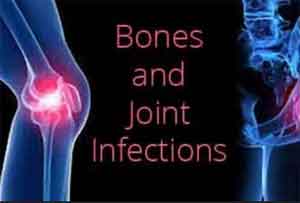- Home
- Editorial
- News
- Practice Guidelines
- Anesthesiology Guidelines
- Cancer Guidelines
- Cardiac Sciences Guidelines
- Critical Care Guidelines
- Dentistry Guidelines
- Dermatology Guidelines
- Diabetes and Endo Guidelines
- Diagnostics Guidelines
- ENT Guidelines
- Featured Practice Guidelines
- Gastroenterology Guidelines
- Geriatrics Guidelines
- Medicine Guidelines
- Nephrology Guidelines
- Neurosciences Guidelines
- Obs and Gynae Guidelines
- Ophthalmology Guidelines
- Orthopaedics Guidelines
- Paediatrics Guidelines
- Psychiatry Guidelines
- Pulmonology Guidelines
- Radiology Guidelines
- Surgery Guidelines
- Urology Guidelines
Oral antibiotics as good as intravenous in complex bone infections: NEJM

Oral antibiotic therapy is sufficient for the treatment of joint infections, according to a pragmatic open-label study.
The study, published in the New England Journal of Medicine, found that the use of oral antibiotic therapy during the first 6 weeks of treatment of complex joint and bone infections is non-inferior to intravenous antibiotic treatment.
The management of complex orthopedic infections usually includes a prolonged course of intravenous antibiotic agents. Matthew Scarborough, John Radcliffe Hospital in Oxford, England, and colleagues investigated whether oral antibiotic therapy is noninferior to intravenous antibiotic therapy for complex orthopaedic infections.
Please also read -GOI Antibiotic Guideline For Bones And Joint Infections
Participants were randomly assigned to have either oral or intravenous treatment to begin no more than 7 days after surgery or treatment initiation and to be given for 6 weeks, with follow-on oral treatment permitted. The choice of antibiotics was made by specialists based on factors such as susceptibility, local epidemiologic patterns, previous infections, and potential drug interactions. Treatment failure (possible, probable, or definite) was evaluated according to clinical criteria, such as the presence of a draining sinus tract, or by microbiologic or histologic criteria.
Patients randomized to the oral therapy group could receive intravenous treatment for up to 5 days for an intercurrent infection.
The initial study protocol called for a five percentage point margin for noninferiority, but following an interim analysis, the margin was adjusted to 7.5 percentage points.
Patients' median age was 60, and almost two-thirds were men. Initial surgical procedures included debridement and removal of joint implant or device, and in more than half of the patients, the deep-tissue histologic analysis identified an infection.
The most common organisms were Staphylococcus aureus and coagulase-negative staphylococcus.
Also Read: Children with bone, joint infection often carry the same infectious bacteria in throat
Key Findings:
- Treatment failure by 1 year was reported in 14.6% of patients receiving intravenous therapy and 13.2% of those given oral antibiotics.
- The difference in treatment failure between the intravenous and oral groups was -1.4 percentage points (95% CI -5.6 to 2.9), which met the prespecified noninferiority margin.
- Possible or probable treatment failures occurred in 1.2% of the intravenous-treatment group and 2% of the oral group, and the difference in risk of any treatment failure was -0.7 percentage points (95% CI -5.1 to 3.8).
- More patients in the intravenous group discontinued treatment early (18.9% vs 12.8%, P=0.006) and had complications from the intravenous catheter (9.4% vs 1%, P<0.001). These patients also had significantly longer hospital stays -- 14 compared with 11 days (P<0.001).
- There were no differences between the groups in the rates of Clostridium difficile diarrhea or serious adverse events.
- Adjunctive oral rifampin was used by 15.6% of the intravenous group and 51.5% of the oral group; no difference in outcome was seen according to the planned use of this additional agent. For patient-reported outcomes, similar improvements were seen in both groups on the European Quality of Life 5 Dimensions scale and the Oxford Hip Score, but the oral group had greater improvements on the Oxford Knee Score.
Also Read: GOI Antibiotic Guideline For Bones And Joint Infections
Complex bone and joint infections have routinely been treated with initial surgery followed by a long course of intravenous antibiotics, which "reflects a broadly held belief that parenteral therapy is inherently superior to oral therapy," despite the risks, costs, and inconvenience of intravenous treatments, the researchers explained. "Our results thereby challenge a widely accepted standard of care."
In an accompanying editorial, Helen W. Boucher, MD, of Tufts University School of Medicine in Boston, said that on the basis of the data, targeted oral therapy may have a role in the treatment of selected patients who have osteomyelitis.
"Although the resulting trial population was heterogeneous, the advantages of generalizability outweigh the disadvantages of heterogeneity," the researchers said, adding that a more selective trial design would have limited the utility of the results.
In her editorial, Boucher sounded a note of caution: "At this time, it is premature to recommend a widespread early switch to oral therapy for bone and joint infection," she wrote. "Further studies are needed to confirm these findings and will further inform these strategies and advance stewardship to decrease antimicrobial resistance."
For further reference log on to 10.1056/NEJMoa1710926

Disclaimer: This site is primarily intended for healthcare professionals. Any content/information on this website does not replace the advice of medical and/or health professionals and should not be construed as medical/diagnostic advice/endorsement or prescription. Use of this site is subject to our terms of use, privacy policy, advertisement policy. © 2020 Minerva Medical Treatment Pvt Ltd